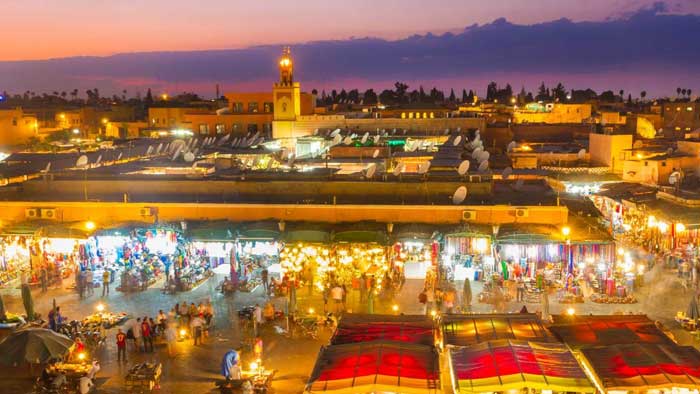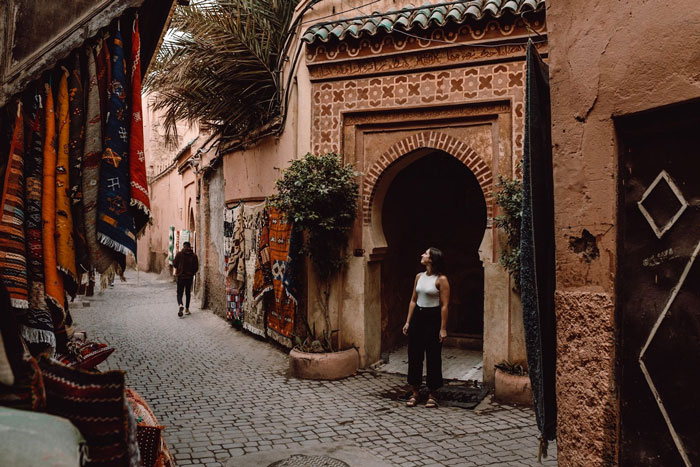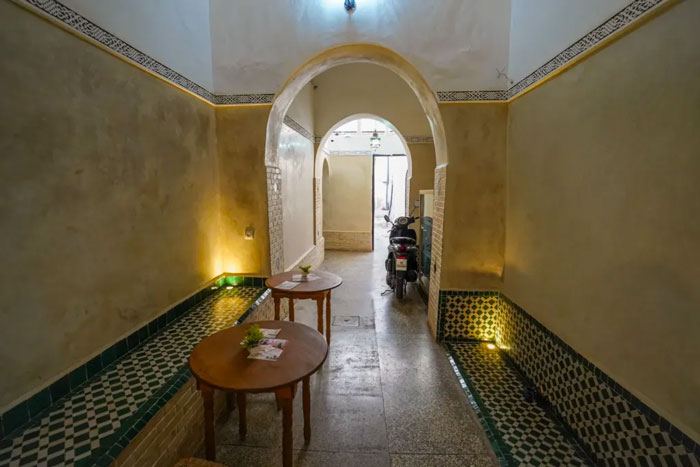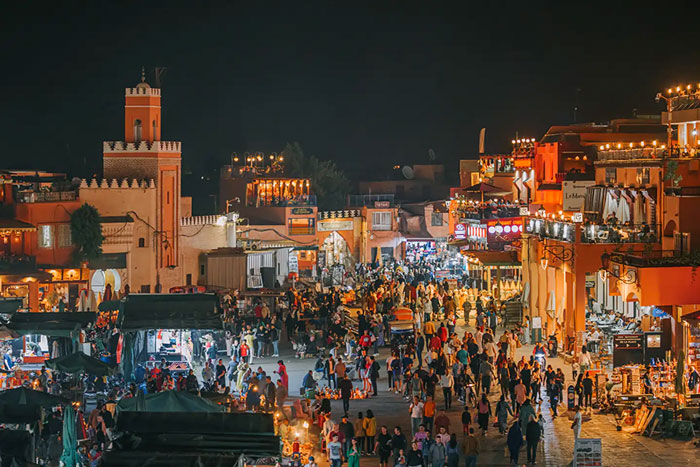Things to Do in Marrakech – Walk in Marrakech as a Local
Discover Marrakech One Step at a Time
Marrakech isn’t just a destination; it’s a living, breathing tapestry of color, sound, and scent. Known as the Red City for its clay-colored buildings, Marrakech offers an experience that goes far beyond the usual tourist attractions. To truly understand its soul, you need to slow down, walk its winding streets, and observe the rhythms of daily life.
Walking in Marrakech as a local is an entirely different journey. You’re not just following a map to landmarks, you’re following the scent of sizzling tagine from a street-side stall, the echo of the call to prayer from a nearby mosque, or the laughter of children playing in shaded alleyways. Every turn reveals something unexpected: an ancient door, a hidden courtyard, or a craftsman at work.
This blog post is your invitation to explore Marrakech on foot, through the eyes of its residents. Whether you’re a curious traveler, a street photography enthusiast, or a lover of local culture, walking like a local will connect you to Marrakech in ways no tour ever could. Leave the guided paths behind—let’s uncover the real Marrakech, one step at a time.
Start at Jemaa el-Fnaa – The Heartbeat of Marrakech
If there’s one place that captures the spirit of Marrakech, it’s Jemaa el-Fnaa. More than just a historic square, it’s the beating heart of the city, a stage where everyday life unfolds from dawn to midnight. For locals, it’s not just a tourist attraction; it’s where people meet, eat, shop, and celebrate. To walk in Marrakech like a local, this is where your journey should begin.
In the morning, the square slowly comes to life. You’ll see orange juice vendors squeezing fresh fruit under striped awnings, herbalists arranging colorful spices, and henna artists setting up their stalls. Locals often pass by on their way to work, pausing to grab a cup of mint tea or some beghrir pancakes from a roadside stall. This is the perfect time to observe the city waking up and to enjoy a slower pace before the crowds arrive.
By late afternoon and evening, Jemaa el-Fnaa transforms completely. The air fills with the smell of grilled meats, cinnamon, and incense. Drummers and musicians gather in circles, street performers draw laughter from children, and storytellers mesmerize small crowds with tales passed down through generations. It’s chaotic, enchanting, and deeply Moroccan. Locals come here to enjoy street food, reconnect with friends, or simply soak in the ambiance after a long day.
To experience the square like a true Marrakchi:
-
Pause and watch. Don’t rush—take time to stand still and observe.
-
Try the street food. Locals love stalls like No. 14 for fried fish or No. 32 for grilled lamb skewers.
-
Avoid common tourist scams. Politely say no to unsolicited guides or aggressive vendors.
-
Blend in. Dress modestly, stay relaxed, and smile; it goes a long way in Marrakech.
Jemaa el-Fnaa isn’t just a place to visit. It’s a place to feel alive. Begin your Marrakech walking adventure here, and let the rhythm of the square guide your senses deeper into the city’s hidden wonders.

Wander Through the Medina Like a Marrakchi
Leaving the vibrancy of Jemaa el-Fnaa behind, step into the Medina of Marrakech, a labyrinth of narrow alleyways, secret riads, bustling souks, and centuries-old architecture. To walk through the Medina like a local is to slow your pace, follow your curiosity, and let your senses guide you rather than a strict itinerary.
The Medina isn’t just for tourists; it’s home. Marrakchis live, work, shop, and socialize here. As you wander, you’ll pass by tiny barbershops tucked into corners, children playing with makeshift toys, and locals chatting over coffee or buying fresh bread from neighborhood ovens. There’s a beautiful rhythm to the daily life here, and when you walk without rush, you become part of that rhythm too.
One of the most fascinating aspects is the souk experience. But unlike tourists who often rush to the main lanes, locals know the value of the quieter, deeper alleys. Go beyond the obvious and discover specialized markets:
-
Souk Semmarine for traditional clothing and textiles.
-
Souk Haddadine for blacksmiths and ironworkers.
-
Souk Cherratine for high-quality leather goods.
-
Rahba Kedima for herbs, spices, and magical charm ingredients.
What truly sets you apart as a respectful visitor is how you engage with the people. Greet shopkeepers with a warm “Salam Alaikum,” smile, and if you want to haggle, do it kindly. For locals, bargaining is not a confrontation but a cultural game of charm and wit.
Another way to walk like a Marrakchi is to look up and around. Notice the intricate door carvings, the zellij tilework on walls, the smells wafting from kitchens, and the echoing calls from distant mosques. These details paint a picture of Marrakech’s soul that no guidebook can capture.
Lastly, don’t be afraid to get lost. Some of the most magical moments happen when you take an unfamiliar turn and stumble upon a hidden fountain, a local artisan workshop, or a peaceful courtyard where time seems to stand still.

Visit Neighborhoods Beyond the Tourist Track
While the Medina and Jemaa el-Fnaa draw most of the attention, the real charm of walking like a local in Marrakech lies in exploring the lesser-known neighborhoods, areas where daily life flows at a gentler pace and where you’re more likely to hear the sounds of conversations than camera clicks.
Bab Doukkala – Everyday Marrakech
Just northwest of the Medina, Bab Doukkala offers a window into the working-class rhythm of the city. This neighborhood is known for its traditional markets, fresh produce stalls, butchers, and tailors. Locals shop here for their daily essentials, and the prices reflect that—there are no tourist markups. Walking through Bab Doukkala feels like stepping into the authentic heartbeat of Marrakech, where the people are friendly, and life is refreshingly real. It’s a great place to grab a street-side snack, such as fresh msemen (Moroccan pancake) or warm bread straight from a clay oven.
Sidi Ghanem – The Creative District
If you’re interested in design and contemporary Moroccan creativity, take a taxi (or long walk) to Sidi Ghanem on the outskirts of the city. This industrial zone has become a haven for Moroccan designers, artists, and craftspeople. Here, locals browse minimalist furniture stores, handmade lighting boutiques, fashion ateliers, and natural beauty product workshops. It’s a place where the modern Marrakchi community expresses its evolving taste while still honoring traditional techniques. Sidi Ghanem is quiet, curated, and filled with beautiful surprises for the curious walker.
Gueliz and Hivernage – Where Locals Live Modern Lives
To see the more modern side of Marrakech, head to Gueliz and Hivernage. Built during the French colonial period, Gueliz is home to locals who enjoy shopping at international stores, sipping espresso at Parisian-style cafés, and dining in trendy restaurants. Walking here, you’ll see Marrakchis dressed in both Western and traditional styles, going about their day much like city dwellers in any cosmopolitan space.
Hivernage, by contrast, is greener and more residential. Locals stroll its clean boulevards in the evening or relax in luxury hotel lounges and rooftop bars. It’s where you’ll find music venues, cultural centers, and upscale nightlife. While less “authentic” in the traditional sense, it offers insight into the lifestyle of Marrakech’s modern middle class.
Exploring these neighborhoods on foot not only gets you away from the crowds, but also gives you a deeper, more nuanced understanding of how locals live in a city that constantly balances history with the present.
Ready to Lose Yourself in the Magic of Marrakech?
Wander through ancient alleyways, sip mint tea on sunlit rooftops, and immerse yourself in the colors, sounds, and soul of one of the world’s most captivating cities. Marrakech isn’t just a destination; it’s an experience that touches your heart and awakens your senses.
✨ Book your journey today and walk Marrakech like a local, one unforgettable step at a time.
Eat Where Locals Eat – Street Food & Hidden Gems
One of the most delightful ways to walk like a local in Marrakech is to follow your nose, quite literally. The city is a paradise for food lovers, and while many restaurants cater to tourists, the real gems are the small eateries and street food stalls frequented by Marrakchis every day.
As you wander through the Medina and nearby neighborhoods, you’ll spot modest food stands and hole-in-the-wall cafés that may not look flashy but serve dishes that are rich in flavor and authenticity. Locals know where to go for the best taste at the best price, and you can learn a lot by simply observing where the queues form.
Street Food Must-Try Dishes:
-
Msemen & Harcha – Griddled flatbreads served hot with honey, cheese, or jam, perfect for breakfast or a midday snack.
-
Maakouda – Deep-fried potato patties, crunchy on the outside and soft inside, often sold near school zones or local markets.
-
Snail Soup (Babbouche) – A spicy broth believed to have healing properties, sold from wheeled carts in the evening.
-
Briouats – Savory or sweet stuffed pastries, often filled with meat, cheese, or almonds and honey.
-
Harira Soup – A tomato-based soup with lentils, chickpeas, and vermicelli, traditionally eaten during Ramadan but available year-round.
Local Eateries and Cafés:
Step into a traditional Moroccan eatery known as a majliss or beldi restaurant, where you’ll likely find construction workers, shopkeepers, and families sharing tagines around aluminum tables. These places may not have English menus, but that’s part of the charm. You’ll often be welcomed with warm smiles and hearty portions of kefta tagine, couscous, or grilled sardines.
For something sweet, visit a local pastry shop (patisserie) and try chebakia, ghriba, or fekkas with a glass of steaming mint tea. If you prefer something cooler, avocat aux fruits secs (avocado shake with dried fruits and nuts) is a local favorite, especially during summer.
If you’re unsure where to start, consider joining a local-led food tour. These are often guided by Marrakchis who know all the best hidden spots and offer insight into not just what to eat, but why it matters to the local culture.
Eating like a local in Marrakech is not just about the food; it’s about the experience: sharing space, slowing down, and tasting a piece of the city’s daily life, one bite at a time.
Explore Traditional Hammams and Local Wellness Rituals
Walking through Marrakech like a local isn’t just about sights and tastes; it’s also about understanding how the people care for themselves, rest, and reconnect. One of the most rooted traditions in Moroccan daily life is the hammam experience. For locals, visiting a hammam isn’t just a luxury; it’s a weekly ritual of cleanliness, renewal, and community.
A traditional Moroccan hammam is a public bathhouse where locals gather to scrub away the week’s dust, sweat, and stress. It’s a social space, often gender-segregated, where friends catch up, mothers wash their children, and everyone leaves feeling refreshed and purified, body and soul.

Visit Community Spaces and Gardens
After navigating the energetic chaos of the Medina, locals often seek moments of calm and connection in Marrakech’s public gardens and community spaces. These green corners and gathering spots are where daily life slows down, where people come to relax, talk, read, or simply sit in the shade. For travelers walking like locals, they offer an authentic look at the quieter side of Marrakech.
Le Jardin Secret – A Tranquil Hidden Gem
Tucked away behind high walls in the middle of the Medina, Le Jardin Secret lives up to its name. Though often visited by tourists, it’s also appreciated by Marrakchis for its peaceful atmosphere and beautiful architecture. Reconstructed in the style of Islamic gardens, it features tiled walkways, flowing fountains, and shady palm trees. Locals who work nearby sometimes stop in for a break from the heat and noise, especially during quieter hours.
Cyber Park (Arsat Moulay Abdeslam) – A Local Favorite
Just steps from the Koutoubia Mosque lies Cyber Park, one of the few open-air public spaces in the city center. This well-maintained garden is a favorite among locals, students studying on benches, families picnicking, and couples strolling hand in hand. It’s also historically significant, blending 18th-century design with modern touches like free Wi-Fi terminals (hence the name). For a genuine slice of local life, come here in the late afternoon and sit among the Marrakchis who treat it like their urban backyard.
Koutoubia Gardens – Relaxing with a View
Surrounding Marrakech’s iconic Koutoubia Mosque, these gardens offer open space and floral beauty with a backdrop of one of the city’s most important religious landmarks. The gardens are not just for admiring architecture; they’re a local social hub. In the evenings, you’ll find families gathering for a stroll, children playing, and elderly men deep in conversation on benches. It’s a quiet, scenic space to unwind and observe the city’s rhythm.
Small Parks and Neighborhood Squares
Outside the tourist zone, small pocket gardens and neighborhood squares host spontaneous football games, old men playing cards, and women chatting while their children play. These places might not be on travel guides, but they are essential parts of daily life. If you’re staying in a local riad or guesthouse, ask your host where the nearest local park is. You may find a peaceful gem just around the corner.
Exploring Marrakech’s green spaces isn’t just about taking a break. It’s about joining the city’s flow, watching how people interact, and feeling what it’s like to be part of the community, even for a little while.
Pray or Pause: Religious and Spiritual Sites Locals Respect
To truly walk in Marrakech like a local, it’s important to understand the spiritual rhythm that shapes daily life in the city. For Marrakchis, faith is not just private; it flows through the streets, rises with the call to prayer, and is reflected in quiet moments of pause, reflection, and gratitude. While many religious sites are closed to non-Muslims, you can still respectfully observe and appreciate their significance from the outside.
Koutoubia Mosque – The Symbol of Marrakech
Dominating the skyline near Jemaa el-Fnaa, the Koutoubia Mosque is the largest and most iconic mosque in Marrakech. With its stunning 77-meter-high minaret, it’s not only a spiritual center but also a landmark locals use for orientation when walking the city. Non-Muslims aren’t permitted to enter, but the gardens surrounding the mosque are open to all and offer a peaceful spot to reflect. When the call to prayer (adhan) rings out from the minaret, stop and listen—it’s a moment that connects everyone in the city, even in silence.
Zawiyas and Smaller Shrines
Scattered throughout the Medina are small religious sites known as zawiyas, which are shrines built around the tombs of Sufi saints. Many Marrakchis visit these places to pray, light candles, or reflect quietly. While you may not be able to enter, you can still admire the decorative tilework, carved doors, and calm atmosphere around them. Zawiya Sidi Bel Abbes and Zawiya of Sidi Ben Slimane are two such sites that hold deep local reverence.
Understanding Local Prayer Routines
Five times a day, the adhan echoes from minarets across the city, calling the faithful to prayer. You’ll notice shops close temporarily, taxi drivers pull over, and people pause what they’re doing to find a quiet corner to pray. As a visitor, it’s respectful to step aside during prayer times, especially near mosques or in smaller community areas.
How to Respect Religious Spaces
-
Don’t try to enter mosques unless you’re invited (some riads offer special arrangements).
-
Dress modestly when walking near religious sites—cover shoulders and knees as a sign of respect.
-
Avoid loud conversations, taking selfies, or eating near people breaking their fast during Ramadan.
Marrakech is not just a city of color and sound; it’s a city of faith, where the sacred is seamlessly woven into the everyday. By walking attentively and respecting these spiritual sites, you’ll not only show consideration, but you’ll also experience a deeper, quieter layer of local life.
Walk the Walls – Discover the Ramparts and City Gates
One of the most captivating ways to explore Marrakech like a local is to take a walk along the ancient city walls (ramparts) that have protected the Medina for centuries. These walls, built from red clay, stretch for about 19 kilometers and are punctuated by impressive gates, each with its own history and character. Walking along and between these gates not only connects you with the city’s past but also reveals contrasting neighborhoods and daily life beyond the tourist zones.
The Significance of the Medina Walls
The walls of Marrakech were originally constructed in the 12th century under the Almoravid dynasty to safeguard the city from invaders. Today, they remain a symbol of the city’s resilience and heritage. Locals often use the paths alongside these walls as shortcuts or leisurely strolls, enjoying the views and shade they provide.
Notable City Gates to Explore
-
Bab Agnaou: The grand ceremonial gate on the south side of the Medina, adorned with intricate geometric patterns. It once served as the main entrance for royalty and dignitaries.
-
Bab Doukkala: On the northwest corner, this gate opens into the vibrant Bab Doukkala neighborhood, giving you access to local markets and everyday life.
-
Bab el-Khemis: Known for its bustling weekly market, this gate leads to one of the city’s liveliest local hubs.
-
Bab er-Robb: A quieter gate in the south with surrounding olive groves and fewer tourists.
What to Expect on Your Walk
Walking near the ramparts allows you to see how the old meets the new. On one side, you have the walled Medina with its crowded souks and narrow alleys; on the other, more modern districts with wider streets and open markets. Along the walls, you might encounter locals going about their business, children playing soccer in open spaces, and vendors selling fresh fruit.
Tips for Walking the Walls
-
Start at one gate and plan your route to explore several others.
-
Early morning or late afternoon are the best times to avoid the midday heat.
-
Wear comfortable shoes; some areas are uneven.
-
Carry water and sun protection.
-
Take your time to stop and appreciate the details on the walls and gates, each tells a story.
Walking the ramparts is more than a sightseeing activity; it’s a chance to experience the layers of Marrakech’s history and the daily pulse of its people, from the quiet edges of the city to the lively neighborhoods just beyond.
Marrakech by Night – Local Night Walks
As the sun sets and the temperatures cool, Marrakech reveals a whole new side of its vibrant personality. Walking through the city at night like a local offers a magical blend of illuminated architecture, lively street scenes, and a more relaxed pace that invites exploration beyond the daytime hustle.

Evening Strolls Around Jemaa el-Fnaa and Medina
At night, Jemaa el-Fnaa transforms into a bustling open-air restaurant with countless food stalls filling the air with aromas of grilled meats, spices, and sweet treats. Locals gather here to share meals, laughter, and stories under strings of twinkling lights. Walking through the square and nearby Medina alleys after dark is an experience of sensory richness, the sounds of musicians, the glow of lanterns, and the chatter of neighbors create a festive yet intimate atmosphere.
Safe Night Walking Areas for Locals and Visitors
While Marrakech is generally safe, it’s wise to stick to well-lit, populated areas such as:
-
The Medina’s main thoroughfares
-
The streets around Place des Épices
-
The neighborhoods of Gueliz and Hivernage, where many locals and expats spend their evenings
These areas are filled with cafés, lounges, and rooftop bars offering panoramic views of the city and the Atlas Mountains. Walking between these spots gives you a feel for Marrakech’s modern nightlife blended with tradition.
Night Markets and Late-Night Cafés
Some local markets stay open late into the evening, especially during festivals or weekends, offering handicrafts, textiles, and street food. Small cafés serve mint tea and strong coffee, where locals linger over games of chess or cards. These gatherings are great opportunities to meet residents and see the city’s social life unfold naturally.
What to Keep in Mind When Walking at Night
-
Dress modestly and comfortably, blending with local styles.
-
Avoid isolated or poorly lit streets.
-
If you’re unsure of your route, ask a trusted local or your riad staff.
-
Keep your belongings secure but don’t appear overly cautious to maintain a relaxed vibe.
Walking Marrakech by night allows you to see the city’s warmth and hospitality in a different light, both literally and figuratively. It’s a chance to slow down, connect with locals, and enjoy the peaceful rhythms that come with the desert breeze.
Responsible Walking Tips in Marrakech
Exploring Marrakech on foot like a local is a rewarding adventure, but it also requires mindfulness and respect. To ensure your experience is positive, for both you and the people you meet, keep these important tips in mind:
Dress Modestly and Respectfully
Marrakchis appreciate visitors who honor their cultural norms. Wearing clothes that cover shoulders and knees is recommended, especially when walking through religious areas or traditional neighborhoods. Lightweight, breathable fabrics work best in the warm climate.
Be Mindful of Personal Space and Photography
Always ask permission before taking photos of people, especially women and children. Many locals are friendly but value their privacy. Respect signs that prohibit photography in markets or religious sites.
Respect Local Customs and Practices
-
Greet with a friendly “Salam Alaikum” (peace be upon you).
-
Use your right hand when giving or receiving items.
-
Avoid loud conversations or disruptive behavior in quiet areas.
-
During Ramadan, be considerate by not eating or drinking in public during daylight hours.
Stay Safe and Aware
-
Keep an eye on your belongings, especially in crowded places.
-
Be cautious of overly persistent vendors or unofficial guides.
-
Walk with confidence, and if you get lost, don’t hesitate to ask locals politely for directions.
-
Stick to well-lit streets after dark.
Support Local Businesses and Artisans
Choose to buy souvenirs, food, and services from local vendors and artisans rather than large tourist shops. This helps the community economically and encourages sustainable tourism.
Leave No Trace
Help keep Marrakech clean by disposing of trash properly and avoiding damage to historic sites or gardens.
By walking responsibly, you not only enrich your own experience but also contribute to preserving the authenticity and beauty of Marrakech for future visitors and locals alike.
Conclusion – Embrace the Magic of Marrakech on Foot
Walking through Marrakech like a local opens a world far beyond the typical tourist experience. It’s about slowing down, noticing the small details, and connecting with the people who call this vibrant city home. From the bustling energy of Jemaa el-Fnaa to the quiet serenity of hidden gardens, every step reveals a new story, a new flavor, and a deeper appreciation for Morocco’s rich culture.
Whether you’re savoring street food from a humble stall, exploring the ancient Medina’s winding alleys, or sharing a moment of calm in a local hammam, walking Marrakech allows you to feel its heartbeat in an intimate and unforgettable way.
So, lace up your walking shoes, bring an open mind, and step into the rhythms of Marrakech. The city is waiting to welcome you, not as a tourist, but as a guest discovering its soul.
Ready to experience Marrakech like a local? Start your journey today, one step at a time!
